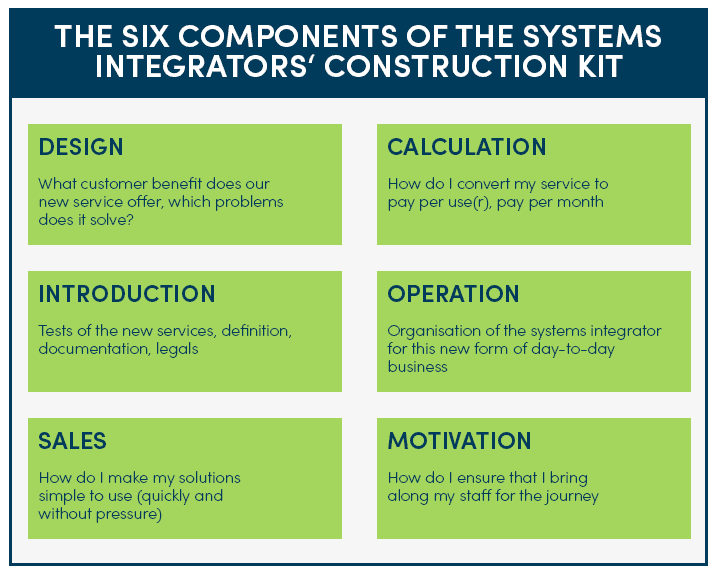[oc_spacer height=”15″]Increasingly customers request services from the cloud and managed services. Systems integrators, who would like to utilise this business opportunity, have to position themselves accordingly. We have talked with ICT entrepreneurs Mike Bergmann (Exabyters) and Marcel Sternkopf (SecureHead IT) about the necessity to rethink. The digital transformation in industry, economy and society continues to take shape. The intensity with which companies use cloud services is growing and it is already clear that organisations will operate their IT primarily in hybrid architectures and allow service providers to manage their applications. This development signifies a paradigm shift for systems integrators and a new understanding of the roles: From time against money to efficiency against money, from workman on demand to a “Managed Service Provider 2.0“ (MSP 2.0).
“Systems integrators, who can offer ‘new‘ services such as Workplace-as-a-Service, will be perceived by customers as an attractive partner“, finds Marcel Sternkopf, managing director of systems integrator SecureHead IT. “In keeping with ones own safeguarding of the future, the pragmatic approach is to take over more and more of a customer‘s IT operational responsibility as an ‘MSP 2.0‘.“
Of course, positioning as an MSP and development of complementary competencies/cooperations cannot be achieved overnight. “A systems integrator, who takes this seriously and develops comprehensive managed services in parallel to their existing core business, will start to see the effect after around six months. It takes around two years to break even and experience sustainable success with the MSP-2.0 model.“ This is the assessment by Mike Bergmann, the founder of Exabyters in Uelzen, who for the past six years in seminars has trained and advised other systems integrators (for example on behalf of acmeo) as well as delivered individual consultancy with regards to digital business models. In the ICT sector and sector specialists‘ cooperations such as iTeam, Bergmann is known as one of the most well-known ‘missionaries‘ for managed services and an early advocate of IT flat rates.
MSP 2.0 with Plan
Besides the six basic components (see graphic), a prequisite for the transformation from a conventional provider to a MSP 2.0 is an internal organisation, which allows the application of the economical principle: to look after as many customers as possible with the lowest possible effort and maximised results.
This requires a high degree of automation and in-house MSP technicians who, as a trustworthy customer interace, are better suited than conventional sales people. And „… not least a commission model, which takes away the sales team’s fear of the new model“, reports Sternkopf. He positioned his systems integrator SecureHead IT right from the start as an MSP 2.0. In his other role as partner manager at oneclick, Sternkopf also understands the sensitivities, challenges and needs, which other systems integrators experience with regards to their customers‘ digital transformations.
Source: Mike Bergmann, Exabyters (own illustration)
New Pillars: Convenience & Consulting
According to Bergmann‘s and Sternkopf’s experience, the biggest challenge for ICT channel businesses willing to change is to ‘pole change‘ their thinking from reactive to active“.
Those who may be able to achieve this, would successfully score with customers with the two pillars Convenience and Consulting. An example would be an Application Delivery/Workplace-as-a-Service, which is already on offer today by partners of oneclick AG. After Consulting (from consultation and clarification of the legal position about the questions how standardised the applications are, up to necessity of procedural and organisational changes), such services become a “Convenience“ for customers: Apart from the convenience of no longer having to look themselves after a seamless operation of their applications and simply being able to call up individual workspaces via browser, customers also benefit from predictable expenditure for their IT.
“The oneclick Workspace Provisioning and Streaming Platform is ideal for users, who work with a high number of standardised applications, have seasonal workforce fluctuations or have to manage many decentralised workspaces“, reports Bergmann. “As soon as companies recognise what this is all about, they often think of various possible applications. From then on the systems integrator partner (ie the MSP 2.0) can speak justifyably about customer driven services.“
Customers enjoy fix cost model
With conventional event driven enquiries, it is possible that obscure hourly rates for service technicians accrue, while around the clock “Managed Services 2.0“ is highly automated and offers predictable fixed costs. The customer always pays a fixed price for support, “similar to a tenant, who transfers a certain rent per square meter to a landlord and does not need to look after the operation of the house nor its maintenance and modernisation“, according to Bergmann.
The example of a former seminar participant shows just how profitable the business model MSP can be. Nowadays he can already cover 120 percent of his fixed costs at the beginning of each month with the flat rates of his customers alone.

